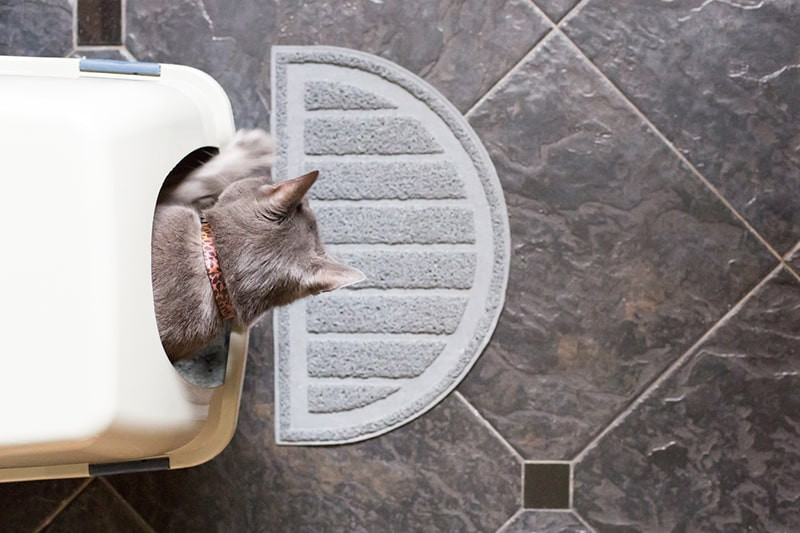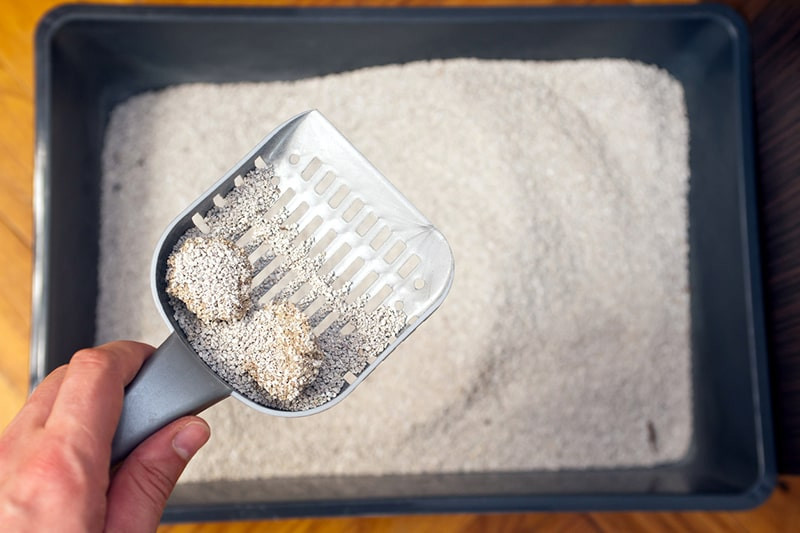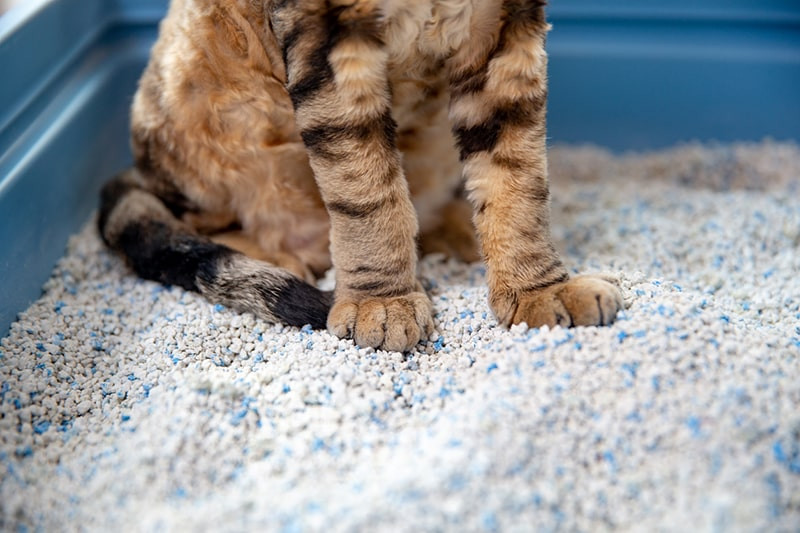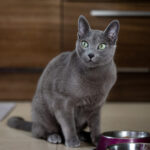Is your feline friend’s bathroom routine a mystery? Understanding your cat’s bowel movements is essential for their health and well-being, and solcat.net is here to guide you. This comprehensive guide dives into the frequency of cat poop, what’s considered normal, and when to seek veterinary advice. Learn how to identify healthy stool, recognize potential digestive issues, and create an environment that supports your cat’s comfortable and regular elimination.
1. How Often Should a Cat Poop Each Day?
Generally, a healthy cat will poop once or twice a day. Poop frequency can vary from cat to cat depending on factors such as diet, age, activity level, and overall health. If you notice a significant change in your cat’s pooping habits, it’s wise to consult with a veterinarian.
- Diet: A cat’s diet plays a crucial role in their digestive health. High-quality cat food that’s rich in fiber can promote regular bowel movements.
- Age: Kittens might poop more frequently than adult cats due to their faster metabolism and smaller digestive systems.
- Hydration: Adequate water intake is essential for healthy digestion. Dehydration can lead to constipation, which affects poop frequency.
- Health conditions: Certain medical conditions, such as hyperthyroidism, inflammatory bowel disease (IBD), and parasites, can affect a cat’s pooping habits.
 Gray cat exiting a covered litter box
Gray cat exiting a covered litter box
2. What is Considered Normal Cat Poop?
Normal cat poop should be firm but not too hard, dark brown in color, and well-formed. Consistency, color, and odor can indicate your cat’s digestive health, so it is essential to monitor these factors regularly.
- Consistency: Healthy poop should have a Play-Doh-like consistency. It shouldn’t be too runny (diarrhea) or too hard (constipation).
- Color: Dark brown is the ideal color. Black, tarry stool can indicate digested blood, while pale or clay-colored stool can suggest liver or gallbladder issues.
- Odor: While cat poop isn’t going to smell like roses, overly foul-smelling stool can be a sign of digestive upset or infection.
- Shape: Healthy poop should be shaped like logs or segments. Small, hard pellets can indicate constipation.
- Frequency: Once or twice daily is typical, but some cats may poop more or less frequently depending on individual factors.
3. What are the Signs of Unhealthy Cat Poop?
Unhealthy cat poop can manifest in several ways, including diarrhea, constipation, blood in the stool, or changes in color or odor. Recognizing these signs early can help you seek timely veterinary care for your feline friend.
- Diarrhea: Loose, watery stool that may contain mucus or blood. It can be caused by diet changes, infections, parasites, or underlying medical conditions.
- Constipation: Hard, dry stool that’s difficult to pass. It can be caused by dehydration, lack of fiber, hairballs, or obstructions.
- Blood in stool: Bright red blood can indicate bleeding in the lower digestive tract, while dark, tarry stool can suggest bleeding higher up.
- Changes in color: Pale, clay-colored stool can indicate liver or gallbladder problems. Black, tarry stool can suggest digested blood.
- Changes in odor: Overly foul-smelling stool can be a sign of infection, inflammation, or malabsorption.
- Straining: Difficulty passing stool, which can indicate constipation or an obstruction.
- Increased frequency: Pooping more often than usual, which can indicate diarrhea or other digestive upset.
- Decreased frequency: Pooping less often than usual, which can indicate constipation.
4. What are the Potential Causes of Abnormal Cat Poop?
Several factors can contribute to abnormal cat poop, including dietary issues, infections, parasites, stress, and underlying medical conditions such as inflammatory bowel disease (IBD) or hyperthyroidism. Identifying the root cause is essential for effective treatment.
| Cause | Description | Symptoms |
|---|---|---|
| Dietary Issues | Sudden changes in diet, food allergies, or intolerances. | Diarrhea, vomiting, gas, abdominal pain. |
| Infections | Bacterial, viral, or fungal infections in the digestive tract. | Diarrhea, vomiting, fever, loss of appetite. |
| Parasites | Intestinal parasites such as roundworms, hookworms, or Giardia. | Diarrhea, vomiting, weight loss, poor coat quality. |
| Stress | Anxiety or stress can disrupt the normal digestive process. | Diarrhea, vomiting, loss of appetite, changes in behavior. |
| Inflammatory Bowel Disease (IBD) | Chronic inflammation of the digestive tract. | Diarrhea, vomiting, weight loss, loss of appetite. |
| Hyperthyroidism | Overproduction of thyroid hormones, which can affect digestion. | Increased appetite, weight loss, hyperactivity, diarrhea. |
| Obstructions | Foreign objects, tumors, or other blockages in the intestines. | Vomiting, loss of appetite, abdominal pain, straining to poop. |
| Cancer | Tumors in the digestive tract can affect bowel movements. | Weight loss, loss of appetite, vomiting, diarrhea or constipation. |
| Pancreatitis | Inflammation of the pancreas, which can disrupt digestion. | Vomiting, loss of appetite, abdominal pain, diarrhea. |
| Kidney Disease | Advanced kidney disease can cause changes in bowel habits. | Vomiting, loss of appetite, weight loss, increased thirst and urination. |
| Liver Disease | Liver problems can affect the color and consistency of stool. | Pale or clay-colored stool, vomiting, loss of appetite, jaundice. |
| Medications | Some medications can cause digestive upset as a side effect. | Diarrhea, vomiting, loss of appetite. |
5. How Can I Help My Cat with Poop Problems?
Supporting your cat’s digestive health involves several strategies, including providing a high-quality diet, ensuring adequate hydration, managing stress, and seeking veterinary care when necessary. Regular check-ups and proactive care can help prevent and address poop-related issues.
- High-quality diet: Feed your cat a balanced diet that’s appropriate for their age, activity level, and health condition.
- Hydration: Ensure your cat has access to fresh, clean water at all times. Consider adding wet food to their diet to increase moisture intake.
- Fiber: Add fiber supplements or high-fiber cat food to help regulate bowel movements.
- Probiotics: Probiotics can help restore the balance of gut bacteria, which can improve digestion.
- Stress management: Minimize stress in your cat’s environment by providing a safe, comfortable, and predictable routine.
- Regular exercise: Encourage regular physical activity to promote healthy digestion and bowel movements.
- Veterinary care: Consult with your veterinarian if you notice any significant changes in your cat’s pooping habits or if they’re experiencing digestive upset.
 Scooping out a cat litter box
Scooping out a cat litter box
6. What are the Different Types of Cat Litter and How Do They Affect Poop?
The type of cat litter you use can impact your cat’s pooping habits. Clay litter, clumping litter, crystal litter, and natural litter each have unique properties that can affect stool consistency and odor control. Choosing the right litter can promote both your cat’s comfort and your convenience.
| Litter Type | Description | Pros | Cons |
|---|---|---|---|
| Clay Litter | Made from absorbent clay minerals. | Affordable, readily available. | Dusty, doesn’t control odor as well as other types, can be heavy. |
| Clumping Litter | Made from clay or other materials that clump together when wet. | Easy to scoop, good odor control. | Can be expensive, some cats may ingest it, potentially causing blockages. |
| Crystal Litter | Made from silica gel crystals that absorb urine and dehydrate solid waste. | Excellent odor control, low dust, long-lasting. | Can be expensive, some cats dislike the texture. |
| Natural Litter | Made from renewable resources such as wood, paper, or corn. | Eco-friendly, biodegradable, low dust. | Can be more expensive than clay litter, some cats may not like the texture or odor. |
| Pine Litter | Made from compressed pine shavings or pellets. | Natural odor control, low dust, biodegradable. | Can be bulky, some cats may not like the texture. |
| Paper Litter | Made from recycled paper. | Soft texture, low dust, biodegradable. | Doesn’t control odor as well as other types, can be messy when wet. |
| Walnut Litter | Made from ground walnut shells. | Good odor control, low dust, natural. | Can be more expensive than clay litter, some cats may not like the texture. |
| Grass Litter | Made from dried grass. | Soft texture, good odor control, biodegradable. | Can be more expensive than clay litter, some cats may not like the texture. |
| Tofu Litter | Made from soybean fiber. | Biodegradable, lightweight, good odor control. | Can be more expensive than clay litter, some cats may not like the texture. |
| Scented Litter | Litter with added fragrances to mask odors. | Can help control odors. | Some cats are sensitive to fragrances, which can cause them to avoid the litter box. |
7. How Does Stress Affect a Cat’s Pooping Habits?
Stress can significantly impact a cat’s digestive system, leading to diarrhea, constipation, or changes in litter box habits. Identifying and managing stressors in your cat’s environment is crucial for maintaining their overall health and well-being.
- Causes of stress:
- Changes in routine
- New pets or people in the home
- Loud noises
- Moving to a new home
- Separation anxiety
- Lack of environmental enrichment
- Symptoms of stress:
- Changes in appetite
- Hiding
- Excessive grooming
- Urinating or defecating outside the litter box
- Aggression
- Increased vocalization
- Diarrhea or constipation
- Stress management:
- Provide a stable and predictable routine.
- Create a safe and comfortable environment.
- Provide plenty of environmental enrichment, such as toys, scratching posts, and climbing structures.
- Use pheromone diffusers or sprays to help calm your cat.
- Consult with your veterinarian or a certified animal behaviorist if you’re concerned about your cat’s stress levels.
8. What are Some Common Cat Health Problems That Affect Poop?
Several health conditions can affect a cat’s pooping habits, including inflammatory bowel disease (IBD), hyperthyroidism, parasites, and infections. Recognizing the symptoms of these conditions and seeking veterinary care is crucial for proper diagnosis and treatment.
| Condition | Description | Symptoms |
|---|---|---|
| Inflammatory Bowel Disease (IBD) | A chronic inflammatory condition that affects the digestive tract. | Diarrhea, vomiting, weight loss, loss of appetite, abdominal pain, blood in stool. |
| Hyperthyroidism | A condition in which the thyroid gland produces too much thyroid hormone. | Increased appetite, weight loss, hyperactivity, increased thirst and urination, vomiting, diarrhea. |
| Parasites | Intestinal parasites such as roundworms, hookworms, tapeworms, or Giardia. | Diarrhea, vomiting, weight loss, loss of appetite, abdominal pain, poor coat quality, blood in stool. |
| Infections | Bacterial, viral, or fungal infections in the digestive tract. | Diarrhea, vomiting, fever, loss of appetite, abdominal pain, dehydration. |
| Kidney Disease | A condition in which the kidneys are unable to function properly. | Increased thirst and urination, weight loss, loss of appetite, vomiting, diarrhea, constipation. |
| Liver Disease | A condition in which the liver is unable to function properly. | Loss of appetite, vomiting, diarrhea, jaundice, abdominal swelling, changes in stool color. |
| Pancreatitis | Inflammation of the pancreas. | Vomiting, loss of appetite, abdominal pain, diarrhea, dehydration. |
| Cancer | Tumors in the digestive tract or other organs can affect bowel movements. | Weight loss, loss of appetite, vomiting, diarrhea, constipation, abdominal pain, blood in stool. |
| Diabetes | A condition in which the body is unable to regulate blood sugar levels. | Increased thirst and urination, increased appetite, weight loss, vomiting, diarrhea. |
9. How Can I Prevent Cat Poop Problems?
Preventing cat poop problems involves providing a balanced diet, ensuring adequate hydration, managing stress, maintaining a clean litter box, and scheduling regular veterinary check-ups. Proactive care can help keep your cat’s digestive system healthy and functioning optimally.
- Balanced diet: Feed your cat a high-quality diet that’s appropriate for their age, activity level, and health condition.
- Hydration: Ensure your cat has access to fresh, clean water at all times. Consider adding wet food to their diet to increase moisture intake.
- Stress management: Minimize stress in your cat’s environment by providing a safe, comfortable, and predictable routine.
- Litter box hygiene: Clean the litter box daily and change the litter regularly to prevent bacterial buildup and encourage your cat to use the box.
- Regular exercise: Encourage regular physical activity to promote healthy digestion and bowel movements.
- Veterinary check-ups: Schedule regular veterinary check-ups to monitor your cat’s overall health and detect any potential problems early on.
- Parasite prevention: Administer regular parasite prevention medications to protect your cat from intestinal parasites.
- Avoid sudden diet changes: Introduce new foods gradually to prevent digestive upset.
10. When Should I See a Vet About My Cat’s Poop?
Consult your veterinarian if you notice significant changes in your cat’s pooping habits, such as persistent diarrhea, constipation, blood in the stool, or straining. These symptoms can indicate underlying health issues that require veterinary attention.
- Persistent diarrhea: If your cat has diarrhea for more than 24-48 hours, or if the diarrhea is severe or bloody.
- Constipation: If your cat is straining to poop or hasn’t pooped in more than 48 hours.
- Blood in stool: If you see blood in your cat’s stool, especially if the blood is bright red or if the stool is black and tarry.
- Vomiting: If your cat is vomiting along with changes in their pooping habits.
- Loss of appetite: If your cat has lost their appetite or is refusing to eat.
- Lethargy: If your cat is lethargic or weak.
- Abdominal pain: If your cat is showing signs of abdominal pain, such as guarding their abdomen, hunching over, or vocalizing when touched.
- Weight loss: If your cat is losing weight despite eating normally.
- Changes in behavior: If your cat is acting differently than usual.
- Underlying health conditions: If your cat has any underlying health conditions, such as IBD, hyperthyroidism, or kidney disease.
 Devon rex cat sitting in a clumping cat sand in litter box
Devon rex cat sitting in a clumping cat sand in litter box
Navigating the world of cat poop can be a bit daunting, but solcat.net is here to provide the information and support you need. Remember, monitoring your cat’s bathroom habits and seeking timely veterinary care are essential for their overall health and happiness.
If you’re looking for more information about cat care, health, and behavior, visit solcat.net today. We offer a wealth of resources, articles, and expert advice to help you provide the best possible care for your feline companion.
Address: 950 Alaskan Way, Seattle, WA 98104, United States. Phone: +1 (206) 386-4000. Website: solcat.net.
FAQ About Cat Poop
1. Is it normal for my cat to poop every other day?
While most cats poop once or twice a day, some cats may poop every other day. If your cat’s stool is normal and they’re not showing any signs of discomfort, it may be their regular routine. However, if you notice any changes or concerns, consult your veterinarian.
2. What does healthy cat poop look like?
Healthy cat poop should be firm but not too hard, dark brown in color, and well-formed. It shouldn’t be too runny (diarrhea) or too hard (constipation).
3. Why is my cat’s poop so smelly?
While some odor is normal, overly foul-smelling cat poop can be a sign of digestive upset, infection, or malabsorption. If you’re concerned about the odor of your cat’s poop, consult your veterinarian.
4. What causes diarrhea in cats?
Diarrhea in cats can be caused by diet changes, infections, parasites, stress, or underlying medical conditions such as inflammatory bowel disease (IBD) or hyperthyroidism.
5. What causes constipation in cats?
Constipation in cats can be caused by dehydration, lack of fiber, hairballs, obstructions, or underlying medical conditions such as kidney disease.
6. Is blood in cat poop a cause for concern?
Yes, blood in cat poop is a cause for concern. Bright red blood can indicate bleeding in the lower digestive tract, while dark, tarry stool can suggest bleeding higher up. Consult your veterinarian if you notice blood in your cat’s stool.
7. How can I help my constipated cat?
To help your constipated cat, ensure they have access to fresh water, add fiber to their diet, and encourage regular exercise. You can also consult your veterinarian about stool softeners or other medications.
8. What are some signs of digestive problems in cats?
Signs of digestive problems in cats include diarrhea, constipation, vomiting, loss of appetite, weight loss, abdominal pain, and changes in stool color or odor.
9. How often should I clean my cat’s litter box?
You should clean your cat’s litter box daily and change the litter regularly to prevent bacterial buildup and encourage your cat to use the box.
10. Can stress affect my cat’s poop?
Yes, stress can affect your cat’s digestive system, leading to diarrhea, constipation, or changes in litter box habits. Managing stress in your cat’s environment is crucial for maintaining their overall health and well-being.

